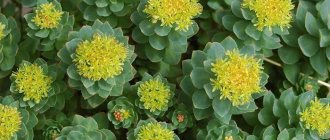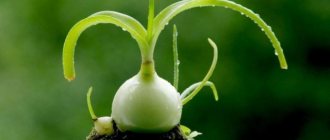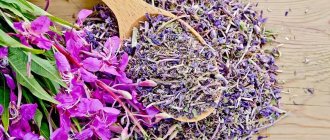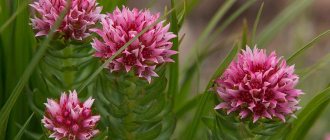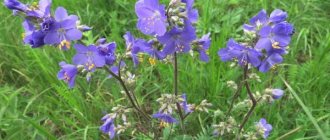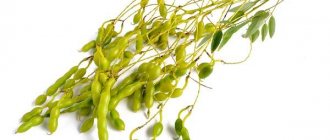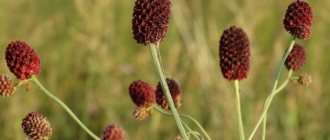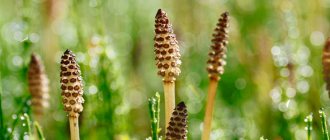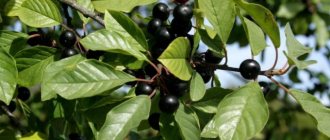Appearance
This is a herbaceous perennial belonging to the buckwheat family. Its erect, unbranched bare stems reach a height of 80–100 cm. The leaves located closer to the base are quite large, lanceolate and have a long petiole. The upper leaves are sessile and smaller.
The leaf blade is dark green in color, wavy at the edges, its lower side is gray, slightly pubescent.
The short, woody, S-shaped rhizome has many adventitious roots. It is thanks to him that this herb bears its name. Another name by which knotweed is known is snakeroot. This part of the plant actually looks a lot like a snake because of its curved appearance. Thanks to its peculiar surface, which has transverse ring-shaped thickenings, the root resembles the tail of a crayfish, which explains another name for the perennial - crayfish neck.
Small pink flowers (2–3 mm), appearing in May–June, are collected at the top of the stem in thick spike-shaped inflorescences up to 7 cm long. They have a subtle, pleasant aroma. The fruits, which are brownish faceted nuts, ripen in July.
The snake knotweed plant reproduces both by seeds and vegetatively. It is distributed almost everywhere in Russia and the CIS, but its most favorite places are forest edges, river banks and damp meadows.
Snake knotweed photo
Grows in moist, acidic soils. You can find the banks of reservoirs, damp meadows or forest edges. The main growing areas of the snake knotweed are Altai, Siberia, and alpine or subalpine belts.
» » » » Folk recipes with knotweed " " " "
Root
This is the most popular part of the coil in folk medicine. The above-ground part is used very rarely. To prepare high-quality medicinal raw materials, you need to be able to distinguish between healthier and stronger roots. Their length can be in the range of 5–10 cm. When broken, the root usually has a pinkish-brown color, tastes bitter, has an astringent taste, and is odorless. It is not recommended to use for treatment roots that have darkened at the fracture, with a large number of small roots, as well as the presence of organic and mineral impurities in the composition.
Botanical characteristics
Perennial herbaceous plant. Distributed in Primorye and Amur region. Grows in flooded and forest meadows, swamps, and bushes.
The rhizome is thick, curved, worm-shaped, reddish at the break. The stem is up to 50 cm tall, straight, simple, with bare tubular bells at the places where the leaves are attached. The basal leaves are oblong-ovate with a blunt or slightly heart-shaped base, turning into a winged petiole, green above, bluish below, wavy along the edge. The upper leaves are smaller and narrower, almost sessile. The flowers are small, collected at the top of the stem into an inflorescence - a cylindrical spike, pink, sometimes white with purple anthers. The fruit is a 3-sided, shiny, brown nut that blooms in May–June and bears fruit in July–August.
Procurement of raw materials
The rhizome of snakeweed can be harvested all year round, but the most suitable time is spring, when the presence of tannins in the root is especially high. The dug up rhizome is carefully cleaned of small roots, the stem is cut off and, after washing in cold water, laid out to dry in the fresh air or in a warm, ventilated room.
The ideal option would be to use a special dryer for this, where it is possible to quickly heat the roots to 40 ⁰C. Slow drying can cause mildew. Snakeweed, prepared in compliance with these simple rules, is able to retain its beneficial properties for 5 years.
When collecting rhizomes, it is recommended to save at least one specimen for every 2 meters of knotweed thickets in order to ensure the self-renewal of the plant.
Preparation
- For infusion, take 20 g of leaves or flowers, pour in 200 ml of boiling water, leave in a boiling water bath for 15 minutes, cool for 45 minutes without removing from the bath, and filter. Take 1/3 cup 2-3 times a day before meals.
- To make a decoction, grind 15 g of rhizomes, pour in 200 ml of boiling water, leave in a bath for 30 minutes, cool for 10 minutes, filter, bring to 200 ml, squeezing out the remainder. Take 2 tbsp. spoons 3-4 times a day before meals.
- For the tincture, take 100 g of rhizomes, crush them, pour in 0.5 liters of 70% alcohol, leave for 10-15 days, filter. Take 30-40 drops per dose 2-3 times a day before meals. To obtain the extract, the tincture is evaporated by half. Take 20-30 drops 2-3 times a day before meals.
Beneficial features
Thanks to its composition, snakeweed has a hemostatic, astringent and anti-inflammatory effect. The tannins in the plant make all medicines prepared from it very effective for intestinal disorders, stomach ulcers, dysentery, and urolithiasis. The astringent properties of knotweed do not appear immediately; this process depends on how quickly the active substances are broken down. The above properties make it possible to use the knotweed plant instead of such well-known remedies as oak bark and burnet.
The effect of knotweed on humans
- strong astringent property for gastrointestinal diseases
- effective against diarrhea not associated with dysentery
- kidney diseases
- scientifically proven anti-inflammatory and hemostatic properties
- folk remedies are used in the treatment of stomatitis
- infusion helps against gingivitis
- tones the uterus
- traditional healers use it to treat stomach and rectal cancer
- increases blood clotting
- constricts blood vessels
- used as a disinfectant in the treatment of purulent wounds
Application
In many cases, decoctions and tinctures prepared from this plant are used. They are effective for diseases such as stomach ulcers, dysentery, women's diseases, nervous disorders, bleeding, cystitis, etc.
Decoctions from the rhizome of snakeweed are taken as a diuretic and choleretic agent. This is an effective remedy for inflammation of the intestines, gallbladder, and vegetative-vascular dystonia. In China, this plant is widely used to treat tumors.
Snake knotweed is also used as an external remedy. In combination with other medicinal plants, it is used, for example, to wash the vagina during leucorrhoea. The serpentine is widely known in dentistry; it helps relieve inflammatory processes on the mucous membrane of the mouth and throat (stomatitis, gingivitis, periodontal disease, tonsillitis, pharyngitis, etc.), a decoction of rhizomes is used as a rinse. Compresses and lotions have a positive effect on long-healing old wounds and trophic ulcers. They are also used for joint diseases.
Rules for collecting and harvesting plants
Snake knotweed (Polygonum bistorts L.) or Crayfish is a perennial herbaceous plant from the buckwheat family.
The rhizome is woody, thick, shortened, sharply curved, black-brown, brownish-pink at the fracture, with numerous thin adventitious roots.
The stem is 30-100 cm high, erect, bare, knotty, unbranched.
The leaves are alternate, oblong, of two types: basal and stem.
The basal and lower stem ones are large, with long winged petioles, oblong or oblong-lanceolate plates with a rounded or heart-shaped base.
The upper, stem ones are small, lanceolate or linear, sessile with a slightly wavy edge, their petiole grows together with the stipules into a membranous tube - a bell.
The inflorescence is a thick, dense, cylindrical spike, later resembling a brush due to the elongation of the peduncles.
The flowers are small, often pink, sometimes white, collected in apical racemes.
The fruit is an ovoid or oval, triangular, shiny, dark brown or greenish-brown nut.
Snake knotweed blooms in May-June, the fruits ripen in June-July. Ripens in June - July.
The snakeweed differs from other species of this numerous genus in its short, thick, serpentinely curved rhizome and dense, dense spike-shaped inflorescence. Therefore, there is practically no danger of confusing him with other highlanders.
Spreading
In Russia, the snake knotweed is found from the Kola Peninsula to Lake Baikal. It grows in floodplain meadows, grassy swamps, in sparse forests, on their edges and clearings, most often on peaty soil, sometimes in thickets of bushes. In the mountains it is found in mossy and shrub tundras, in subalpine and alpine meadows.
Teberda Nature Reserve. Subalpine and alpine meadows, occasionally in the forest belt, 1300-3200 m above sea level. Usually, in some places abundantly.
Snake knotweed, also known as buckwheat, is a perennial herb that unites about a hundred species in the buckwheat family.
The botanical characteristics are similar for all plants of this family, which have a strong rhizome, curved and branched, erect stems and oblong leaves with a carved edge. The plant reaches one and a half meters in height.
Flowering begins in late spring, but more often in June. Buckwheat produces a beautiful pink flower, consisting of a five-membered perianth and eight purple stamens, collected in an oblong, fluffy inflorescence, spike-shaped, measuring up to 6-8 cm.
The fruits of the plant ripen after flowering already in July and early August; they are shiny brown nuts with a triangular cut.
A fairly common plant that prefers to settle in forest-steppe and tundra areas. Grows well in marshy areas and Siberian forests.
Snake knotweed is often popularly called viper grass, snakeweed, calf's tongue, crayfish neck, snake root or turtledove. The plant received such nicknames not only because of the shape of the rhizome, serpentinely curved, but also due to the area where it grows, often swampy and damp, a favorite place for reptiles.
The habitats at Russian latitudes extend from the Murmansk region to Lake Baikal. Knotweed is a cold-resistant plant that is not afraid of frost and waterlogged soils. Growing knotweed is possible in a summer cottage, as well as as a landscape plant. Domesticated buckwheat grows larger and blooms twice a year.
With the initial use of snakeweed, it is difficult to achieve quick positive results, because the astringent properties appear very slowly, since initially, under the influence of digestive juices, the active substances are broken down. But over time, with regular use of this medicinal plant, you can see a good, lasting result.
In order to prepare medicinal raw materials, you need to start digging out the root of snakeweed from August to October. The dug up roots are shaken off the ground, washed thoroughly and the small roots, stems and leaves are peeled off with a knife. After this, the roots are cut into pieces of approximately 10 cm and dried. You need to dry the roots in well-ventilated areas or outdoors in good weather.
In folk medicine, snakeweed is used to treat various diseases, and a decoction is prepared from the roots of snakeweed. It is used for colitis and other acute and chronic intestinal diseases. To prepare a decoction, take one tablespoon of crushed root, pour a glass of boiling water and boil for 20 minutes.
When taken orally, a decoction of knotweed roots is useful for uterine, gastric and other bleeding, as it has a hemostatic effect. The decoction is also taken orally for inflammation of the gallbladder and bladder, and for stomach and duodenal ulcers.
For external use, the decoction is used in the form of lotions for various rashes, bleeding wounds and ulcers, as it has an astringent, anti-inflammatory and hemostatic effect. A decoction of knotweed root is used as a rinse for inflammation of the mucous membrane of the mouth, throat, as well as inflammation of the gums (gingivitis, stomatitis).
Snakeweed is not recommended for pancreatitis, liver disease, large amounts of mineral salts in the urine, as well as oxalic acid.
Take decoctions for intestinal disorders with extreme caution and in small doses, since intestinal spasms are possible in case of an overdose.
Other names: coil, crayfish necks
Blooms in June-July.
All parts of the plant are harvested for medicinal purposes.
Rhizomes are harvested in spring or autumn, at a time when the above-ground part of the plant begins to wither. At this time, the root contains the maximum amount of medicinal substances. I shake off the soil from the roots, clean and wash. It is necessary to dry quickly so that the tannins do not oxidize and the inside of the roots does not turn brown. The shelf life of raw materials is 6 years.
Side effects. With prolonged use, the coil causes constipation, irritation of the digestive tract, nausea and vomiting.
The active ingredients are tannins, oxalic acid, vitamin C, carotene and other substances.
The plant owes its names to the peculiarities of the shape of its rhizome. Snake knotweed has a root that is curved twice, it is slightly flattened, and has transverse folds. Most of all, the root resembles a snake. The color of the root is dark brown, with a slightly pinkish tint inside.
Snake knotweed is widespread everywhere - in bushes, in clearings, and loves to grow in damp places. It is not found only in Central Asia and the Caucasus.
Snake knotweed belongs to the herbaceous shrubs of the buckwheat family and has many popular names. Here are just a few of them: snake grass, viper grass. The plant received its popular names due to the appearance of its rhizome, which resembles a reptile.
Description of the snakeweed: the underground part is dark brown on the outside, pink on the inside, the root is twice curved, slightly flattened on the sides and has folds around the circumference, the above-ground part consists of a stem, several basal leaves and several (1-4) on top. The flowers of the plant are small, pink in color and collected in a spikelet on a high peduncle.
A photo of the snake knotweed gives the impression that it is small in stature, but its size can reach one meter in height. The plant bears fruit with dark brown nuts that are smooth to the touch. Flowering occurs in the second half of May - most of June, and fruiting occurs in July.
Highlander can be found almost everywhere from the Baltic to the Baikal region with the exception of the Caucasus and Central Asian steppes. It prefers damp places and can be adjacent to shrubs or grow in open spaces.
Dosage forms and dosages
Basically, the rhizome of the plant is used for treatment, thanks to which snakeweed is so highly valued. The properties of this part of the plant, described above, are used to create a variety of forms of medicine.
A decoction is prepared from crushed rhizomes (pieces of no more than 3 mm are taken), which are filled with water (10 g of raw material per 200 ml of water) and placed in a water bath for 30 minutes. After this, the broth is filtered and taken 1 spoon before meals 3 times a day. If you need to prepare a remedy for external use, take 2 tablespoons of finely chopped root per 1 liter of water.
To prepare the tincture you will need 100 g of crushed rhizomes and 0.5 liters of 70 percent alcohol. The mixture is infused for 12–14 days. You need to take 25-30 drops before meals. An extract can be obtained from the tincture by evaporation.
To make an infusion from the root, it is crushed, placed in a thermos, filled with boiling water, and closed. After 8 hours it is ready for use. It is taken in the same way as a decoction.
Snakeweed can be used to treat skin problems in the form of an ointment, which is prepared by mixing the juice of fresh roots with Vaseline or butter in a 1:2 ratio.
What it looks like and where it grows
Snake knotweed, crayfish, or large serpentine (Bistorta officinalis) is a herbaceous perennial plant of the Buckwheat family. It has a straight, slightly branched stem up to 1.5 m high and a thick, curved root of a dark red color with folds on the surface.
Snake knotweed leaves are arranged in an alternate pattern on petioles, longer at the bottom and shorter at the top. The shape of the plates is oblong or lanceolate with slight wavy edges. The upper surface of the leaves is green, underneath they are bluish.
From May to June, snake knotweed bears dense, spike-shaped inflorescences consisting of small pale pink, red or white buds. The fruits of the plant are brown triangular nuts with a smooth and shiny surface.
Snake knotweed can grow in wetlands
Knotweed is widespread in the temperate climate of the Northern Hemisphere, found in the European part of Russia and Siberia, and grows in steppe zones, forests and tundra. It chooses moist, slightly acidic soils and well-lit places to live; it develops in peat and floodplain meadows and along the banks of reservoirs.
Recipes
For dysentery, small enemas are made from a decoction prepared from serpentine and orchis tubers. Bleeding from internal organs, for example, with a stomach ulcer, will help stop a decoction of crushed knotweed root with flax seeds (a teaspoon of both in a glass of water). Also in such cases, it is effective to use a tincture, which is prepared from equal parts of rhizome and vodka. The mixture should be kept in a dark place for 21 days, after which it should be taken 30 drops at a time.
When getting rid of stones in the gall and bladder, you should not limit yourself to just taking a decoction of the serpentine. It is also required to adhere to a diet that excludes foods such as meat, fish, lard and eggs. Bed rest is recommended.
As already mentioned, snakeweed, a description of the beneficial properties of which is given in this article, is effective for washing the vagina during leucorrhoea in combination with other plants. So, for 20 g of the serpentine rhizome cut into pieces, take another 10 g of shepherd's purse, 15 g of mistletoe leaves, 10 g of water pepper, the same amount of immortelle flowers and oak bark. Ten spoons of this mixture are poured with two liters of water, boiled for about forty minutes, then cooled and used for douching.
Medicinal recipes with snakeweed
The infusion can narrow blood vessels, improve blood clotting, get rid of viscosity, the uterus will contract faster, tone will increase, intestinal motility will improve, and cardiac function will improve.
The plant extract has a diuretic effect on the body, they are advised to treat atonic, chronic, spastic constipation. To prepare an infusion based on the plant, you need to brew the herb in a glass of boiling water and leave for about an hour. The dosage should be selected for each individual. The infusion can be used to treat hemorrhoidal bleeding, fissures, and as a douche for colpitis.
If blood discharge appears during cystitis, you need to use an infusion, with its help you can relieve inflammation, pain, and stop bleeding. A person feels much better when he takes the herb for a malignant tumor in the bladder.
Bird knotweed is used to treat dysentery, and is sometimes used for cholecystitis. If there is an inflammatory process in the skin, you need to use lotions and powders. It is advised to rinse the mouth with medicines for stomatitis and scurvy.
Women are advised to use it for cystitis, vaginitis, and colpitis. The flowers of bird's-eye knotweed contain flavonoids. The aerial part contains mucus, silicon acid, saponin, and tannin. Tea from the plant is used to treat coughs and lung diseases. If you use it regularly, you can restore your metabolism and cleanse your blood.
To prepare an infusion based on the plant, you need to take a glass of boiling water, 3 tablespoons of knotweed, heat everything for about 20 minutes, cool for an hour. Add a glass of water. Use morning, afternoon and evening before meals.
To prepare a decoction based on bird knotweed, you need to take a tablespoon of the plant, add 300 ml of water, boil for 30 minutes, and cool. Drink before meals.
You can remove stones from the bladder using knotweed juice; to do this, you need to take a plant, squeeze the juice from it, and collect it when it flowers. Drink 100 ml, add honey. Due to the fact that the plant contains flavonoids, tannins, and silicon, you can lower blood pressure.
For diarrhea, use a decoction that has an astringent effect; to prepare it, you need to take crushed knotweed root and add 350 ml of water. You can also use an extract based on snakeweed, 25 drops are enough, first dilute with water, drink in the morning, at lunch, and in the evening. It is recommended to use the powder in dry form and dilute it with warm water.
To cure gingivitis and stomatitis, you need to take knotweed root, pour a glass of boiling water over it, and rinse with the decoction twice a day. Can be replaced with tincture, first diluted with water. You need to rinse your mouth with tincture of knotweed with iodine. Use the extract to lubricate the gums.
Contraindications
Snake knotweed is an herb whose use as a medicinal plant requires caution and knowledge of its side effects and contraindications.
The presence of tannins, for which the serpentine root is famous, makes its use unacceptable for constipation and spastic colitis. It is not recommended to take products prepared from it if the filtering function of the kidneys is weakened, or if there is an excessive amount of mineral salts in the urine. You can cause serious harm to your health by incorrectly using a coil for cholelithiasis. Here, along with the use of snakeweed, strict adherence to an appropriate diet is required.
Although snakeweed is not a toxic plant, the beneficial properties and contraindications of this plant should be taken into account when creating preparations based on it at home.
Rhizome extract
A pharmaceutical preparation, liquid extract of rhizomes of snakeweed (Extractum Bistortae fluidum), is prepared from a medium-sized rhizome by extracting 70% alcohol in a 1:1 ratio. It appears to be a clear liquid, red-brown in color, highly astringent, bitterish taste. The content of tannins is not less than 18%. Take 20-30 drops 2-3 times a day before meals.
At home, the extract is prepared from large rhizomes. Pour the crushed rhizome with 70% alcohol in a 1:1 ratio. Leave in a cool, dark place for at least 14 days. Take 20-30 drops 2-3 times a day before meals.
Chemical composition, benefits and harm
The serpentine is characterized by a complex chemical composition, with a high concentration of biologically active substances contained in the root part of the medicinal herb. Compound:
- tannins (25% of the composition);
- ascorbic acid;
- tannin;
- organic acids;
- carotene;
- starch;
- flavonoids.
The plant has a pronounced diuretic, antimicrobial and astringent effect.
Beneficial features:
- promotes the dissolution of gallstones;
- stops pulmonary, intestinal and uterine bleeding;
- accelerates the regeneration of the mucous membrane of the stomach and intestines;
- stops diarrhea;
- removes toxins from the body;
- treats inflammation of the genitourinary system;
- eliminates foci of inflammation in the oral cavity.
Contraindications for snakeweed include:
- tendency to constipation;
- problems with blood clotting;
- pregnancy.
Before using this pharmaceutical herb for therapeutic purposes, you should consult a doctor. The plant is contraindicated for children under two years of age.
